Strange Animals—The Unicorn and the Uroboros
| By: Carl Teichrib; ©2002 |
| Both these animals, often found in mythological and occult works, hold meanings that are contrary to biblical principles. Carl Teichrib explains in this installment of his series. |
- Mysticism and occultism abound with symbols that often point to a transcendental reality beyond conscious understanding.—Nevill Drury, Dictionary of Mysticism and the Occult, p. 249.
- Remember that when we talk and think in symbols, we are placing something between ourselves and reality—something protective, interpretive and significant, but something nevertheless veiling and hiding. —Alice A. Bailey, The Rays and The Initiation, p. 178.
- Symbolical instruction is recommended by the constant and uniform usage of antiquity; and it has retained its influence throughout all ages, as a system of mysterious communication.— Albert Pike, Morals and Dogma, p. 372.
We see symbols every day. They act as an intangible yet authentic language system to those who understand its speech. Of coarse, we are talking of something more allusive than just the common road marker or traffic sign—the symbols in our discussion contain spiritual dimensions, wrapped in centuries of mysticism and occultism. However, this traffic sign allegory is an appropriate metaphor; the symbols we have been studying in our series have been types of “road markers” which point the way to an “alternative doctrine” —all grounded in ancient pagan and mystical belief structures which have been “resurrected” during the last number of decades.
In the world of the occult, those who are trained to interpret and understand these ever-present yet allusive symbols, recognize that certain forces are at work in the world—forces which are spiritual in nature. These symbols hold the keys to esoteric learning, unlocking the occult mysteries and teachings of the ages.
Steeped in the philosophies of pagan mystery religions and secret societies, this “previously underground” religious foundation forms a spiritual alternative to the Biblical worldview; fully equipped with alternative histories, alternative ways of salvation, alternative gods, and alternative realities.
Understanding this greatly amplifies the words of Proverbs 14:12, “There is a way that seems right to a man, but in the end it leads to death.”
Manly P. Hall, one of the most influential occultists of the last century, wrote this of symbols, “They are centers of a mighty force, figures pregnant with an awful power…” (Lectures on Ancient Philosophy, p. 356).
The Mighty Unicorn:
Long considered the stuff of legends and fairy tales, the unicorn—as a symbol—holds a special place in the world of “mystical Christianity” and other esoteric teachings. Manly P. Hall, in his monumental work The Secret Teachings of All Ages, said this concerning the unicorn,
- Mediaeval Christian mystics employed the unicorn as an emblem of Christ, and this creature must therefore signify the spiritual life in man. The single horn of the unicorn may represent the pineal gland, or third eye, which is the spiritual cognition center in the brain.
The unicorn was adopted by the mysteries as a symbol of the illumined spiritual nature of the initiate, the horn with which it defends itself being the flaming sword of the spiritual doctrine against which nothing can prevail.
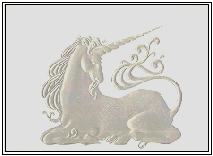
The Penguin Dictionary of Symbolism also connects the unicorn to mystical Christian symbolism, and takes a definitive sexual view of the one-horned beast,
- With its single horn set in the middle of its forehead, the unicorn also symbolizes a spiritual arrow, a sun-ray, the sword of God, divine revelation or the godhead penetrating its creation. In Christian iconography, it stands for the Virgin who has conceived by the Holy Spirit. The single horn may also symbolize a stage upon the way of differentiation, from biological procreation (sexuality) to psychic evolution (a sexual oneness) and to sexual sublimation. This single horn has also been compared with ‘a frontal penis’ or ‘phallus of the psyche,’ the symbol of spiritual fecundity. Yet, at the same time, the unicorn is the symbol of physical virginity. Alchemists regarded it as an image of the hermaphrodite, but this would seen to be a misunderstanding—instead of possessing a twofold sexuality the unicorn transcends sexuality itself. In the Middle Ages the unicorn become the symbol of the Word of God made flesh within the womb of the Virgin Mary.
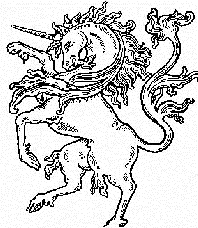
This sexual overtone is also encountered in the wearing of unicorn amulets and charms. Migene Gonzalez-Wippler, the author of The Complete Book of Amulets and Talismans, explains that the unicorn amulet is “a traditional symbol of fertility and sexuality, the unicorn is worn by those who desire to increase their sexual magnetism….”
All of this unicorn symbolism takes on even stranger significance when one advances through the “Practicus Ritual” of the Hermetic Order of the Golden Dawn—a secretive occult society that helped lay the foundation for today’s occult revival. At the end of the ritual, the initiate is given the mystic title of “Monocris de Astris,” which means the “Unicorn from the Stars.”
While there’s little in the way of substantial evidence that the Golden Dawn had officially been involved in “sex-magic” (see Regardie’s What You Should Know About the Golden Dawn, which denies the Order’s involvement in ritualistic sex-magic), some of those initiated into the Order—such as the infamous Aleister Crowley—were directly responsible for introducing “sex magic” (Tantric Yoga) to the West.
Richard Majka, writing in the Rosicrucian Digest (May 1977) on the history of the unicorn, summarized thus concerning the unicorn’s place in spiritual symbolism,
- It may be asked, why should we trouble about a creature that never lived? The only fitting answer is that certain mental constructs—such as symbols—do not need much or any connection with physical reality to be worthy. The unicorn may have been “killed” as an earthbound entity some centuries ago, but the image of the beast as the embodiment of spiritualized force is still valid.
What does all this mean for the child who has unicorn toys, unicorns on their bed-sheets and curtains, unicorn posters, and other such items? Should these all be destroyed in an act of “housecleaning”? First off, you need to keep in mind that to a child these items are understood simply—a horse with a horn. To them, there isn’t anything “esoteric” about them; the child won’t even know what this means. It is almost guaranteed, however, that by radically “housecleaning” you may trigger more questions and problems than if you approached the issue with tact and long-term training in mind.
As I’ve stated in other articles in this series, context is crucial. Moreover, the reason why I’m publishing this information is so that you—through the discernment of the Holy Spirit and God’s Word—can make informed decisions in this age of deception and spiritual chaos.
The Mysterious Uroboros:
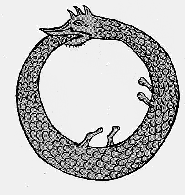
The question immediately comes to mind; what is the Uroboros? Odds are, this creature will not have made it onto your child’s bed-sheets, curtains, or posters. The Uroboros (also spelled Ouroboros) is an ancient serpent symbol—it’s a snake, or a similar creature, eating its own tail.
To the ancient Gnostics, the uroboros represented the self-sustaining ability of nature and a “unity in duality.” Moreover, the Gnostic uroboros was an image of the cosmic serpent which moved through the universe as an ever-present life-force. Patrizia Norelli-Bachelet, in writing of the uroboros, explains, “Herein we see that Spirit and Matter are but different densifications or rates of vibration of the one all-pervading Energy, which to us is the Absolute, God, Brahman” (The Gnostic Circle, p. 110).
Richard Majka, an initiated Rosicrucian, writing in the Rosicrucian Digest (#1, 1995), offers this revealing interpretation of the uroboros,
- In the form of a great circle, this serpent is shown biting its own tail. Its body is depicted in two colors, reflecting light and dark, signifying to the mystic that the material world is good and bad, perfection and imperfection, but all bound together as one. This thought is emphasized by the words that the serpent’s body encircles: “One is all.”
- Among the Gnostics the Ouroboros was the serpent of paradise which planted within humanity a yearning for knowledge. Thus it was thought to be good since it rightly directed humans to knowledge despite all obstacles. For us, today, this mighty serpent remains a vital symbol of the life that we each need to follow. For in learning about the truths of existence on all levels—from the seemingly most trivial to the most universal—we must free ourselves from all shackles to allow our consciousness to spiral upward into higher, more cosmic realms.
Think about what Majka has admitted. The Uroboros is the cosmic unification of good and evil, light and darkness, matter and spirit—he is the representation of All. Moreover, uroboros is the serpent of the Garden of Eden (“serpent of paradise”) which gave man the freedom to use his intellect and knowledge, “despite all obstacles” —God included. Majka also describes him as “good” and “rightly directed humans….” The serpent of Genesis—which tempted Eve and facilitated the Fall of Man—is now an acclaimed champion of humanity!
Of course, the final line of reasoning in Majka’s Rosicrucian Digest article is that we must “free ourselves from all shackles” in order to attain a great cosmic position—eat of the fruit… your eyes will be opened… you will be as God (paraphrase of Genesis 3:4,5). It’s simply the old lie of the Garden rephrased.
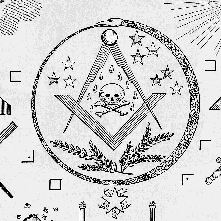
Not surprisingly, the uroboros symbol can be found within the framework of Freemasonry. The adjacent picture is part of a Masonic apron which contains numerous symbols—including an uroboros encircling the Masonic square and compass, the skull and crossbones, and other symbolic items.
The Theosophical Society also uses the uroboros in their material. In fact, the uroboros holds a special place within the official Theosophical seal—it encircles the Ankh/Tao-cross combination and the hexagram, also known as the Seal of Solomon or Star of David. Theosophy, and most of the other esoteric societies, teach that the uroboros is a symbol of wisdom, knowledge, and intellect—all based on the so-called “freedom” offered by the serpent in the Garden of Eden.
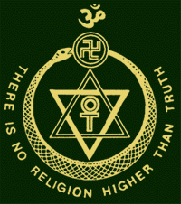
Biblically speaking, we know that man’s wisdom is utter foolishness in the sight of God—and that the “serpent’s wisdom” was and is the pathway to sin and destruction (see Genesis 3). Knowing this, what then does the uroboros really represent?
There is another meaning, an interpretation that is similar yet antithetical to the Gnostic/Rosicrucian/Masonic/Theosophical version. The following interpretation isn’t found in occult literature, but is taken from a logical observation of the symbol itself, and from an understanding of the early chapters of Genesis….
No one in esoteric circles ever mentions the fact that a creature eating its own tail is not nutritious. Rather than granting itself life and freedom, the creature will inevitably choke itself and die. Yes, the uroboros represents Lucifer (see the previous Rosicrucian explanation) —the serpent of Genesis. But viewed through a Biblical lens, the uroboros image is analogous to the perpetuated lie of Genesis 3; “eat… and you will be as God” —with, of course, all of its destructive consequences; eat, and you will perish.
A sobering reminder of the simplicity and truth of Proverbs 14:12; “There is a way that seems right to a man, but in the end it leads to death.”
(Carl Teichrib is a freelance researcher and investigative writer. He can be reached by emailing [email protected].)







[…] Read Part 17 […]
[…] REDIRECT Strange Animals—The Unicorn and the Uroboros […]